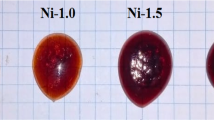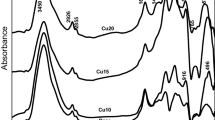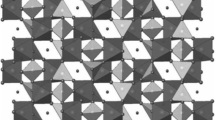Abstract
Germanium borosilicate glasses have attracted attention due to its excellent properties for technological industrial applications, and the tungsten oxide is also widely exploited in diverse technological applications for its distinctive properties. For these reasons, this work studied the effect of tungsten oxide on dielectric constants, conductivity, and density of sodium germanium borosilicate. The results show that dielectric constant (ε′) of sodium germanium borosilicate [Na2B4O7–SiO2–(Ge2O3)15-x–(WO3)x] glasses increased with increasing tungsten oxide (WO3) content and frequency but decreased with increasing temperature. Dielectric loss factor (ε″) of [Na2B4O7–SiO2–Ge2O3–WO3] glasses decreased with increasing frequency but it increased with increasing temperature. Imaginary modulus (M′) of [Na2B4O7–SiO2–(Ge2O3)15-x–(WO3)x] decreased with increasing both temperature and frequency. Imaginary modulus (M″) of [Na2B4O7–SiO2–(Ge2O3)15-x–(WO3)x] increased with increasing temperature up to 400 °k then decreased. Also it increased with decreasing frequency at temperature range from 300 to 400 °k, while decreased with decreasing frequency at temperature range from 410 to 480 °k.











Similar content being viewed by others
Data availability
The data that support the findings of this study are available from the corresponding author upon reasonable request.
References
A.K. Singh, D. Singh, K.S. Thind, G.S. Mudahar, Nucl. Instrum. Methods Phys. Res. Sect. B. 266(1), 140 (2008). https://doi.org/10.1016/j.nimb.2007.10.018
M.H.A. Mhareb, M.A. Almessiere, M.I. Sayyed, Y.S.M. Alajerami, Optik 182, 821 (2019). https://doi.org/10.1016/j.ijleo.2019.01.111
G. Lakshminarayana, A. Kumar, M.G. Dong, M.I. Sayyed, N.V. Long, M.A. Mahdi, J. Non-Cryst. Solids 481, 65 (2018). https://doi.org/10.1016/j.jnoncrysol.2017.10.027
N. Singh, R. Singh, K.J. Singh, K. Sing, Glass Technol. 46(4), 311 (2005)
P. Glumglomchit, J. Rajagukguk, J. Kaewkhao, K. Kirdsiri, Key Eng. Mater. 766, 246 (2018). https://doi.org/10.4028/www.scientific.net/KEM.766.246
P. Kaur, K.J. Singh, S. Thakur, A.I.P. Conf, Proc. 1953(1), 090031 (2018)
Y.S. Alajerami, D. Drabold, M. Mhareb, K.L.A. Cimatu, G. Chen, M. Kurudirek, Ceram. Int. 46(8), 12718 (2020). https://doi.org/10.1016/j.ceramint.2020.02.039
P. Pascuta, L. Pop, S. Rada, M. Bosca, E. Culea, Vib. Spectrosc. 48(2), 281 (2008). https://doi.org/10.1016/j.vibspec.2008.01.011
B. Zhou, H. Lin, B. Chen, E. Yue-Bun Pun, Opt. Express 19(7), 6514–6523 (2011). https://doi.org/10.1364/OE.19.006514
M.T. Sebastian, Dielectric Materials for wireless communication (Elsevier, Amsterdam, 2008). https://doi.org/10.1016/B978-0-08-045330-9.X0001-5
Y. Shimada, Y. Yamashita, H. Takamizawa, IEEE Transaction on Com. 11(1), 163 (1988)
A.A. Higazy, Mater. Lett. 22(5–6), 289 (1995). https://doi.org/10.1016/0167-577X(94)00254-1
R. Vaish, K. Varma, J. Appl. Phys. 106(6), 064106 (2009). https://doi.org/10.1063/1.3225583
H. Pengnian, H. Xihuai, G. Fuxi, J. Non-Cryst, Solids 112(1), 318 (1989). https://doi.org/10.1016/0022-3093(89)90545-0
C.H. Mahmoudi, A. Hassanzadeh, M.M. Golzan, H. Sedghi, M. Talebian, Curr. Appl. Phys. (2011). https://doi.org/10.1016/J.CAP.2010.08.011
B.H. Venkataraman, K.B.R. Varma, Solid State Ionics 167, 197 (2004). https://doi.org/10.1016/j.ssi.2003.12.020
D. Ravinder, G.R. Mohan, P. Nitendarkishan, D.R. Sagar, Mater. Lett. 44, 256 (2000)
L.E. Brus, J. Chem. Phys. 80, 4403 (1984). https://doi.org/10.1063/1.447218
Y. Kayanuma, Solid State Commun. 59(6), 405 (1986). https://doi.org/10.1016/0038-1098(86)90573-9
K. Shimakawa, Phil. Mag. 46, 123 (1982). https://doi.org/10.1080/13642818208246429
H.A.A. Sidek, S. Rosmawati, Z.A. Talib, M.K. Halimah, W.M. Daud, J. Appl Sci. 6(8), 1489 (2009). https://doi.org/10.3844/AJASSP.2009.1489.1494
Funding
Author M. Mundher has received research support from the government grant.
Author information
Authors and Affiliations
Contributions
All authors contributed to the study conception and design. Material preparation, data collection, and analyses were performed by [MM], [AAB], [MAF], and [ABE-B]. The first draft of the manuscript was written by [MH] and [ABE-B] and all authors commented on the previous versions of the manuscript. All authors read and approved the final manuscript.
Corresponding author
Ethics declarations
Conflict of interest
Authors declare they have no financial interests. The authors have no relevant financial or non-financial interests to disclose.
Ethical approval
This paper meets the ethical standards of this journal.
Consent to participate
All authors agree with the review of this paper in this journal.
Additional information
Publisher's Note
Springer Nature remains neutral with regard to jurisdictional claims in published maps and institutional affiliations.
Rights and permissions
Springer Nature or its licensor (e.g. a society or other partner) holds exclusive rights to this article under a publishing agreement with the author(s) or other rightsholder(s); author self-archiving of the accepted manuscript version of this article is solely governed by the terms of such publishing agreement and applicable law.
About this article
Cite this article
Mundher, M., Bendary, A.A., Farag, M.A. et al. Tungsten oxide effects on conductivity, dielectric parameters, and density of sodium germanium borosilicate glass. J Mater Sci: Mater Electron 34, 1069 (2023). https://doi.org/10.1007/s10854-023-10280-6
Received:
Accepted:
Published:
DOI: https://doi.org/10.1007/s10854-023-10280-6




